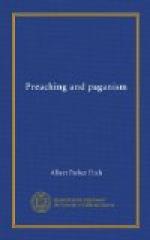[Footnote 22: “Agnosticism,” the Nineteenth Century, February, 1889.]
And no less does the artist, the man of high and correct feeling, perceive the immeasurable distance between uncaring nature and suffering men and women. There is, for instance, the passage in The Education of Henry Adams, in which Adams speaks of the death of his sister at Bagni di Lucca. “In the singular color of the Tuscan atmosphere, the hills and vineyards of the Apennines seemed bursting with midsummer blood. The sick room itself glowed with the Italian joy of life; friends filled it; no harsh northern lights pierced the soft shadows; even the dying woman shared the sense of the Italian summer, the soft velvet air, the humor, the courage, the sensual fullness of Nature and man. She faced death, as women mostly do, bravely and even gayly, racked slowly to unconsciousness but yielding only to violence, as a soldier sabred in battle. For many thousands of years, on these hills and plains, Nature had gone on sabring men and women with the same air of sensual pleasure.
“Impressions like these are not reasoned or catalogued in the mind; they are felt as a part of violent emotion; and the mind that feels them is a different one from that which reasons; it is thought of a different power and a different person. The first serious consciousness of Nature’s gesture—her attitude toward life—took form then as a phantasm, a nightmare, an insanity of force. For the first time the stage scenery of the senses collapsed; the human mind felt itself stripped naked, vibrating in a void of shapeless energies, with resistless mass, colliding, crushing, wasting and destroying what these same energies had created and labored from eternity to perfect.”




